Organisational Behaviour: Culture, Power, and Politics at Toyota
VerifiedAdded on 2023/01/06
|14
|4351
|38
Report
AI Summary
This report offers a comprehensive analysis of organisational behaviour within Toyota, examining the influence of culture, power dynamics, and workplace politics on individual and team performance. It delves into the application of content and process theories of motivation, such as Maslow's Hierarchy of Needs and Vroom's Expectancy Theory, to understand how Toyota motivates its employees and achieves its objectives. The report also explores the characteristics of effective and ineffective teams, utilizing Tuckman's team development theory to illustrate the stages of team formation and evolution. Furthermore, it discusses key concepts and philosophies of organisational behaviour in the context of a business situation, providing insights into how these factors impact the overall success of the company. The analysis highlights the importance of a positive working environment and effective leadership in fostering employee satisfaction and driving productivity within the organisation.
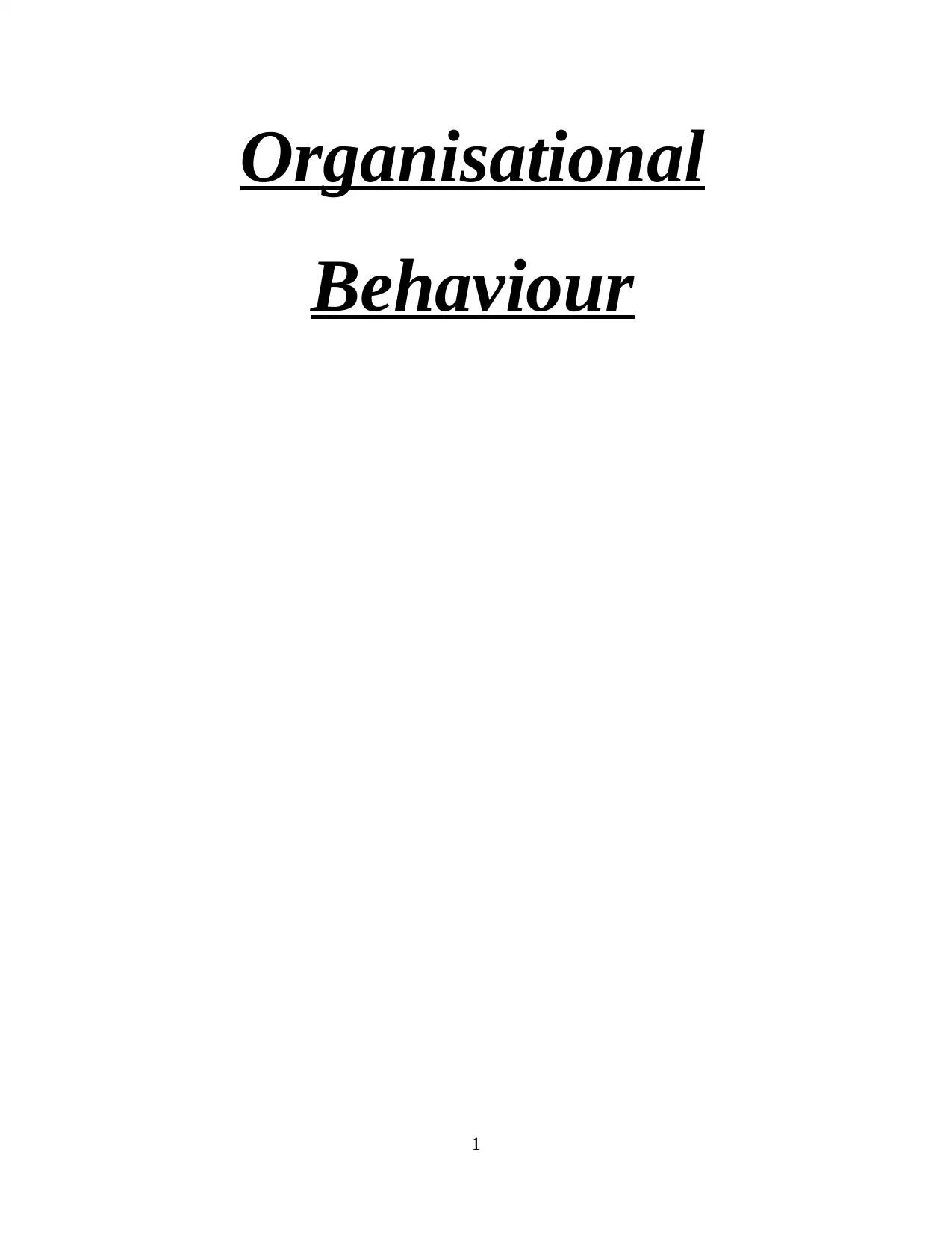
Organisational
Behaviour
1
Behaviour
1
Paraphrase This Document
Need a fresh take? Get an instant paraphrase of this document with our AI Paraphraser
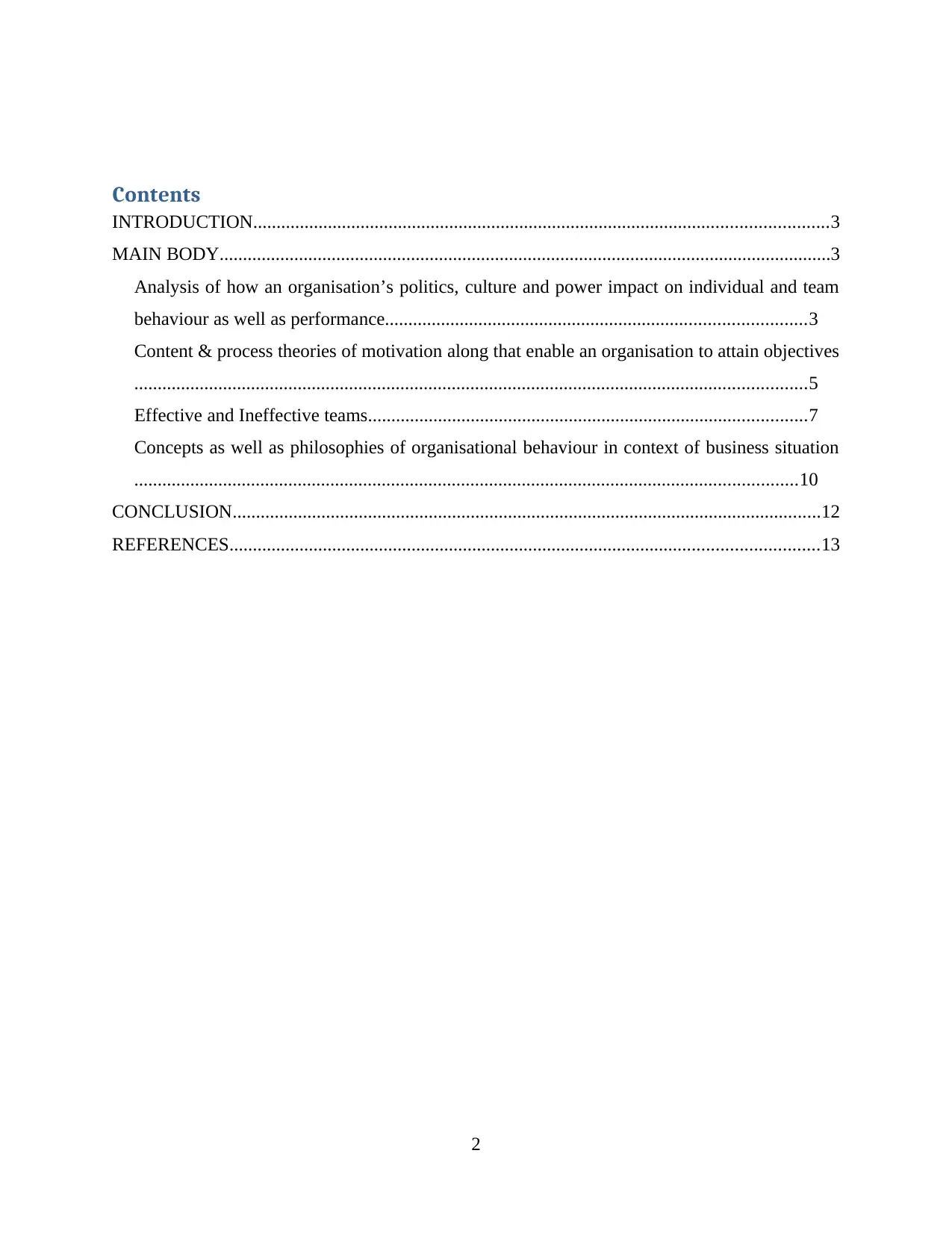
Contents
INTRODUCTION...........................................................................................................................3
MAIN BODY...................................................................................................................................3
Analysis of how an organisation’s politics, culture and power impact on individual and team
behaviour as well as performance..........................................................................................3
Content & process theories of motivation along that enable an organisation to attain objectives
................................................................................................................................................5
Effective and Ineffective teams..............................................................................................7
Concepts as well as philosophies of organisational behaviour in context of business situation
..............................................................................................................................................10
CONCLUSION..............................................................................................................................12
REFERENCES..............................................................................................................................13
2
INTRODUCTION...........................................................................................................................3
MAIN BODY...................................................................................................................................3
Analysis of how an organisation’s politics, culture and power impact on individual and team
behaviour as well as performance..........................................................................................3
Content & process theories of motivation along that enable an organisation to attain objectives
................................................................................................................................................5
Effective and Ineffective teams..............................................................................................7
Concepts as well as philosophies of organisational behaviour in context of business situation
..............................................................................................................................................10
CONCLUSION..............................................................................................................................12
REFERENCES..............................................................................................................................13
2
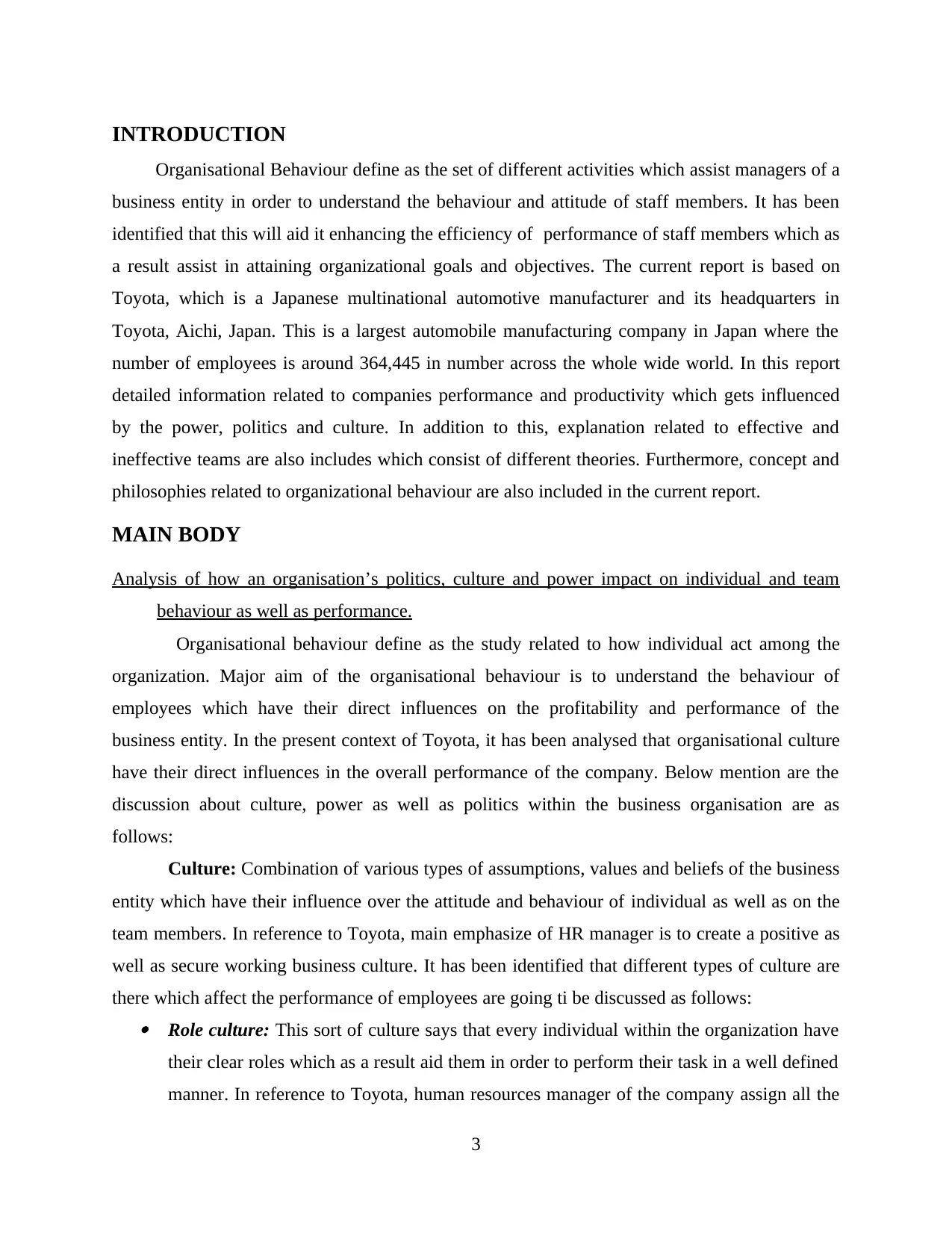
INTRODUCTION
Organisational Behaviour define as the set of different activities which assist managers of a
business entity in order to understand the behaviour and attitude of staff members. It has been
identified that this will aid it enhancing the efficiency of performance of staff members which as
a result assist in attaining organizational goals and objectives. The current report is based on
Toyota, which is a Japanese multinational automotive manufacturer and its headquarters in
Toyota, Aichi, Japan. This is a largest automobile manufacturing company in Japan where the
number of employees is around 364,445 in number across the whole wide world. In this report
detailed information related to companies performance and productivity which gets influenced
by the power, politics and culture. In addition to this, explanation related to effective and
ineffective teams are also includes which consist of different theories. Furthermore, concept and
philosophies related to organizational behaviour are also included in the current report.
MAIN BODY
Analysis of how an organisation’s politics, culture and power impact on individual and team
behaviour as well as performance.
Organisational behaviour define as the study related to how individual act among the
organization. Major aim of the organisational behaviour is to understand the behaviour of
employees which have their direct influences on the profitability and performance of the
business entity. In the present context of Toyota, it has been analysed that organisational culture
have their direct influences in the overall performance of the company. Below mention are the
discussion about culture, power as well as politics within the business organisation are as
follows:
Culture: Combination of various types of assumptions, values and beliefs of the business
entity which have their influence over the attitude and behaviour of individual as well as on the
team members. In reference to Toyota, main emphasize of HR manager is to create a positive as
well as secure working business culture. It has been identified that different types of culture are
there which affect the performance of employees are going ti be discussed as follows: Role culture: This sort of culture says that every individual within the organization have
their clear roles which as a result aid them in order to perform their task in a well defined
manner. In reference to Toyota, human resources manager of the company assign all the
3
Organisational Behaviour define as the set of different activities which assist managers of a
business entity in order to understand the behaviour and attitude of staff members. It has been
identified that this will aid it enhancing the efficiency of performance of staff members which as
a result assist in attaining organizational goals and objectives. The current report is based on
Toyota, which is a Japanese multinational automotive manufacturer and its headquarters in
Toyota, Aichi, Japan. This is a largest automobile manufacturing company in Japan where the
number of employees is around 364,445 in number across the whole wide world. In this report
detailed information related to companies performance and productivity which gets influenced
by the power, politics and culture. In addition to this, explanation related to effective and
ineffective teams are also includes which consist of different theories. Furthermore, concept and
philosophies related to organizational behaviour are also included in the current report.
MAIN BODY
Analysis of how an organisation’s politics, culture and power impact on individual and team
behaviour as well as performance.
Organisational behaviour define as the study related to how individual act among the
organization. Major aim of the organisational behaviour is to understand the behaviour of
employees which have their direct influences on the profitability and performance of the
business entity. In the present context of Toyota, it has been analysed that organisational culture
have their direct influences in the overall performance of the company. Below mention are the
discussion about culture, power as well as politics within the business organisation are as
follows:
Culture: Combination of various types of assumptions, values and beliefs of the business
entity which have their influence over the attitude and behaviour of individual as well as on the
team members. In reference to Toyota, main emphasize of HR manager is to create a positive as
well as secure working business culture. It has been identified that different types of culture are
there which affect the performance of employees are going ti be discussed as follows: Role culture: This sort of culture says that every individual within the organization have
their clear roles which as a result aid them in order to perform their task in a well defined
manner. In reference to Toyota, human resources manager of the company assign all the
3
⊘ This is a preview!⊘
Do you want full access?
Subscribe today to unlock all pages.

Trusted by 1+ million students worldwide
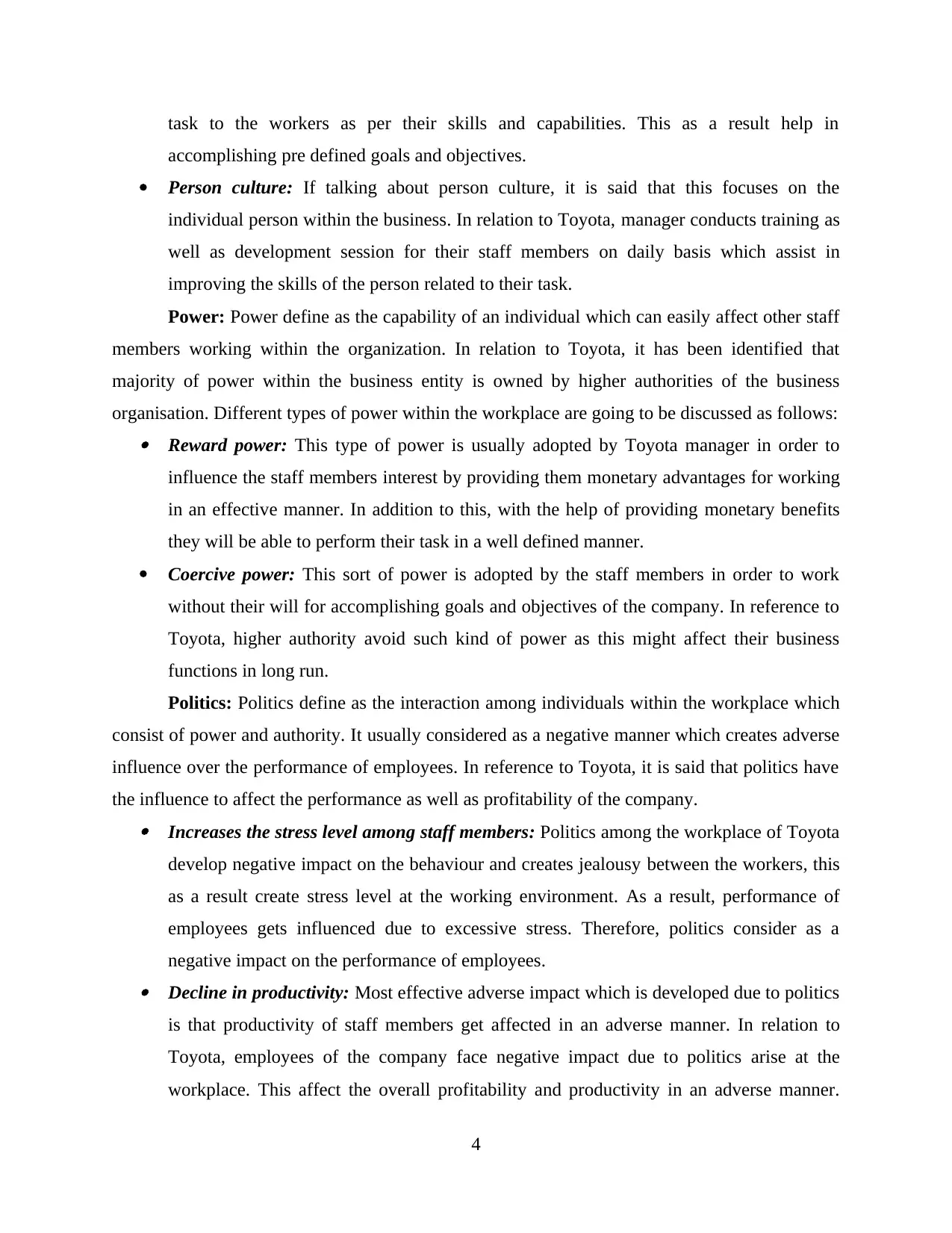
task to the workers as per their skills and capabilities. This as a result help in
accomplishing pre defined goals and objectives.
Person culture: If talking about person culture, it is said that this focuses on the
individual person within the business. In relation to Toyota, manager conducts training as
well as development session for their staff members on daily basis which assist in
improving the skills of the person related to their task.
Power: Power define as the capability of an individual which can easily affect other staff
members working within the organization. In relation to Toyota, it has been identified that
majority of power within the business entity is owned by higher authorities of the business
organisation. Different types of power within the workplace are going to be discussed as follows: Reward power: This type of power is usually adopted by Toyota manager in order to
influence the staff members interest by providing them monetary advantages for working
in an effective manner. In addition to this, with the help of providing monetary benefits
they will be able to perform their task in a well defined manner.
Coercive power: This sort of power is adopted by the staff members in order to work
without their will for accomplishing goals and objectives of the company. In reference to
Toyota, higher authority avoid such kind of power as this might affect their business
functions in long run.
Politics: Politics define as the interaction among individuals within the workplace which
consist of power and authority. It usually considered as a negative manner which creates adverse
influence over the performance of employees. In reference to Toyota, it is said that politics have
the influence to affect the performance as well as profitability of the company. Increases the stress level among staff members: Politics among the workplace of Toyota
develop negative impact on the behaviour and creates jealousy between the workers, this
as a result create stress level at the working environment. As a result, performance of
employees gets influenced due to excessive stress. Therefore, politics consider as a
negative impact on the performance of employees. Decline in productivity: Most effective adverse impact which is developed due to politics
is that productivity of staff members get affected in an adverse manner. In relation to
Toyota, employees of the company face negative impact due to politics arise at the
workplace. This affect the overall profitability and productivity in an adverse manner.
4
accomplishing pre defined goals and objectives.
Person culture: If talking about person culture, it is said that this focuses on the
individual person within the business. In relation to Toyota, manager conducts training as
well as development session for their staff members on daily basis which assist in
improving the skills of the person related to their task.
Power: Power define as the capability of an individual which can easily affect other staff
members working within the organization. In relation to Toyota, it has been identified that
majority of power within the business entity is owned by higher authorities of the business
organisation. Different types of power within the workplace are going to be discussed as follows: Reward power: This type of power is usually adopted by Toyota manager in order to
influence the staff members interest by providing them monetary advantages for working
in an effective manner. In addition to this, with the help of providing monetary benefits
they will be able to perform their task in a well defined manner.
Coercive power: This sort of power is adopted by the staff members in order to work
without their will for accomplishing goals and objectives of the company. In reference to
Toyota, higher authority avoid such kind of power as this might affect their business
functions in long run.
Politics: Politics define as the interaction among individuals within the workplace which
consist of power and authority. It usually considered as a negative manner which creates adverse
influence over the performance of employees. In reference to Toyota, it is said that politics have
the influence to affect the performance as well as profitability of the company. Increases the stress level among staff members: Politics among the workplace of Toyota
develop negative impact on the behaviour and creates jealousy between the workers, this
as a result create stress level at the working environment. As a result, performance of
employees gets influenced due to excessive stress. Therefore, politics consider as a
negative impact on the performance of employees. Decline in productivity: Most effective adverse impact which is developed due to politics
is that productivity of staff members get affected in an adverse manner. In relation to
Toyota, employees of the company face negative impact due to politics arise at the
workplace. This affect the overall profitability and productivity in an adverse manner.
4
Paraphrase This Document
Need a fresh take? Get an instant paraphrase of this document with our AI Paraphraser
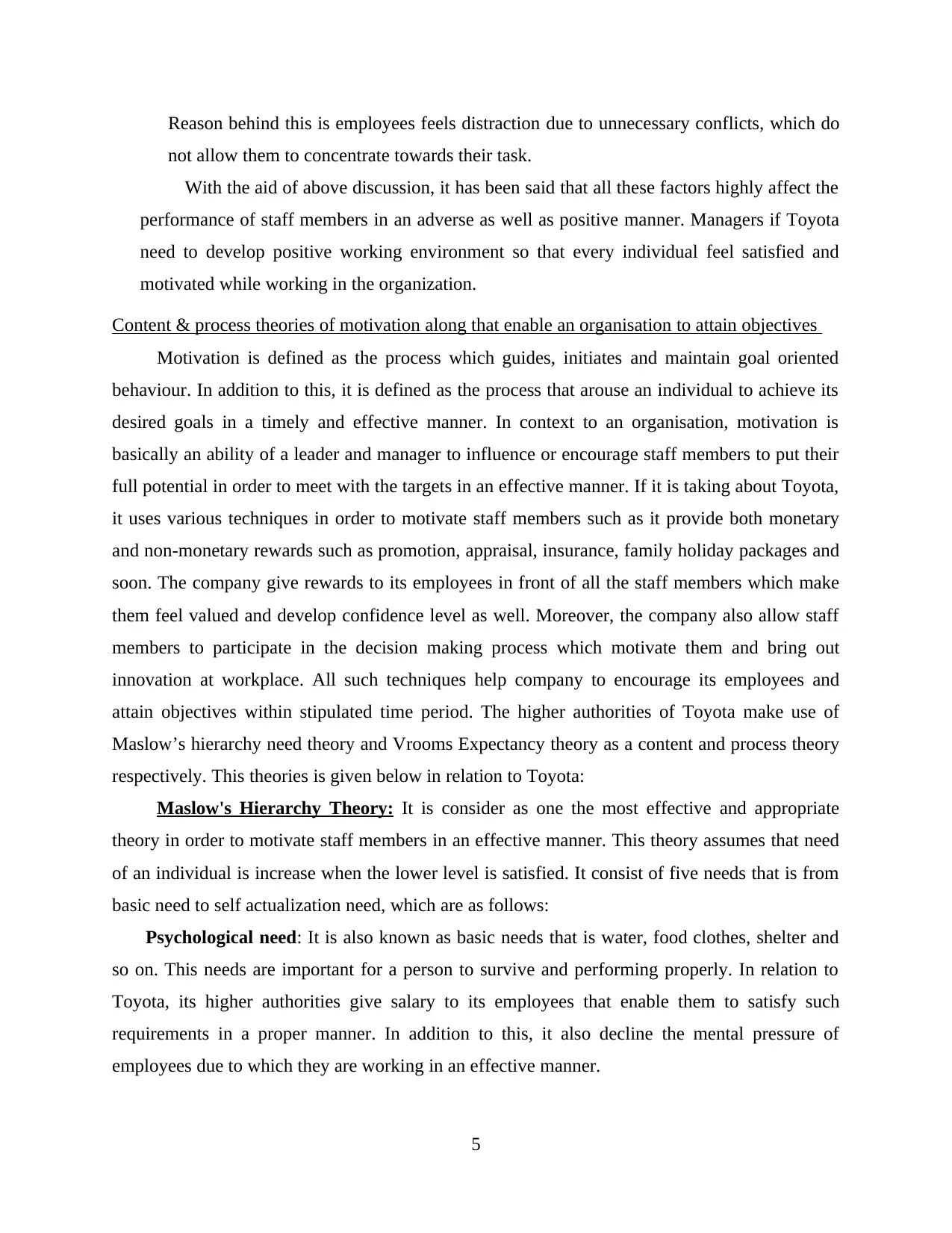
Reason behind this is employees feels distraction due to unnecessary conflicts, which do
not allow them to concentrate towards their task.
With the aid of above discussion, it has been said that all these factors highly affect the
performance of staff members in an adverse as well as positive manner. Managers if Toyota
need to develop positive working environment so that every individual feel satisfied and
motivated while working in the organization.
Content & process theories of motivation along that enable an organisation to attain objectives
Motivation is defined as the process which guides, initiates and maintain goal oriented
behaviour. In addition to this, it is defined as the process that arouse an individual to achieve its
desired goals in a timely and effective manner. In context to an organisation, motivation is
basically an ability of a leader and manager to influence or encourage staff members to put their
full potential in order to meet with the targets in an effective manner. If it is taking about Toyota,
it uses various techniques in order to motivate staff members such as it provide both monetary
and non-monetary rewards such as promotion, appraisal, insurance, family holiday packages and
soon. The company give rewards to its employees in front of all the staff members which make
them feel valued and develop confidence level as well. Moreover, the company also allow staff
members to participate in the decision making process which motivate them and bring out
innovation at workplace. All such techniques help company to encourage its employees and
attain objectives within stipulated time period. The higher authorities of Toyota make use of
Maslow’s hierarchy need theory and Vrooms Expectancy theory as a content and process theory
respectively. This theories is given below in relation to Toyota:
Maslow's Hierarchy Theory: It is consider as one the most effective and appropriate
theory in order to motivate staff members in an effective manner. This theory assumes that need
of an individual is increase when the lower level is satisfied. It consist of five needs that is from
basic need to self actualization need, which are as follows:
Psychological need: It is also known as basic needs that is water, food clothes, shelter and
so on. This needs are important for a person to survive and performing properly. In relation to
Toyota, its higher authorities give salary to its employees that enable them to satisfy such
requirements in a proper manner. In addition to this, it also decline the mental pressure of
employees due to which they are working in an effective manner.
5
not allow them to concentrate towards their task.
With the aid of above discussion, it has been said that all these factors highly affect the
performance of staff members in an adverse as well as positive manner. Managers if Toyota
need to develop positive working environment so that every individual feel satisfied and
motivated while working in the organization.
Content & process theories of motivation along that enable an organisation to attain objectives
Motivation is defined as the process which guides, initiates and maintain goal oriented
behaviour. In addition to this, it is defined as the process that arouse an individual to achieve its
desired goals in a timely and effective manner. In context to an organisation, motivation is
basically an ability of a leader and manager to influence or encourage staff members to put their
full potential in order to meet with the targets in an effective manner. If it is taking about Toyota,
it uses various techniques in order to motivate staff members such as it provide both monetary
and non-monetary rewards such as promotion, appraisal, insurance, family holiday packages and
soon. The company give rewards to its employees in front of all the staff members which make
them feel valued and develop confidence level as well. Moreover, the company also allow staff
members to participate in the decision making process which motivate them and bring out
innovation at workplace. All such techniques help company to encourage its employees and
attain objectives within stipulated time period. The higher authorities of Toyota make use of
Maslow’s hierarchy need theory and Vrooms Expectancy theory as a content and process theory
respectively. This theories is given below in relation to Toyota:
Maslow's Hierarchy Theory: It is consider as one the most effective and appropriate
theory in order to motivate staff members in an effective manner. This theory assumes that need
of an individual is increase when the lower level is satisfied. It consist of five needs that is from
basic need to self actualization need, which are as follows:
Psychological need: It is also known as basic needs that is water, food clothes, shelter and
so on. This needs are important for a person to survive and performing properly. In relation to
Toyota, its higher authorities give salary to its employees that enable them to satisfy such
requirements in a proper manner. In addition to this, it also decline the mental pressure of
employees due to which they are working in an effective manner.
5
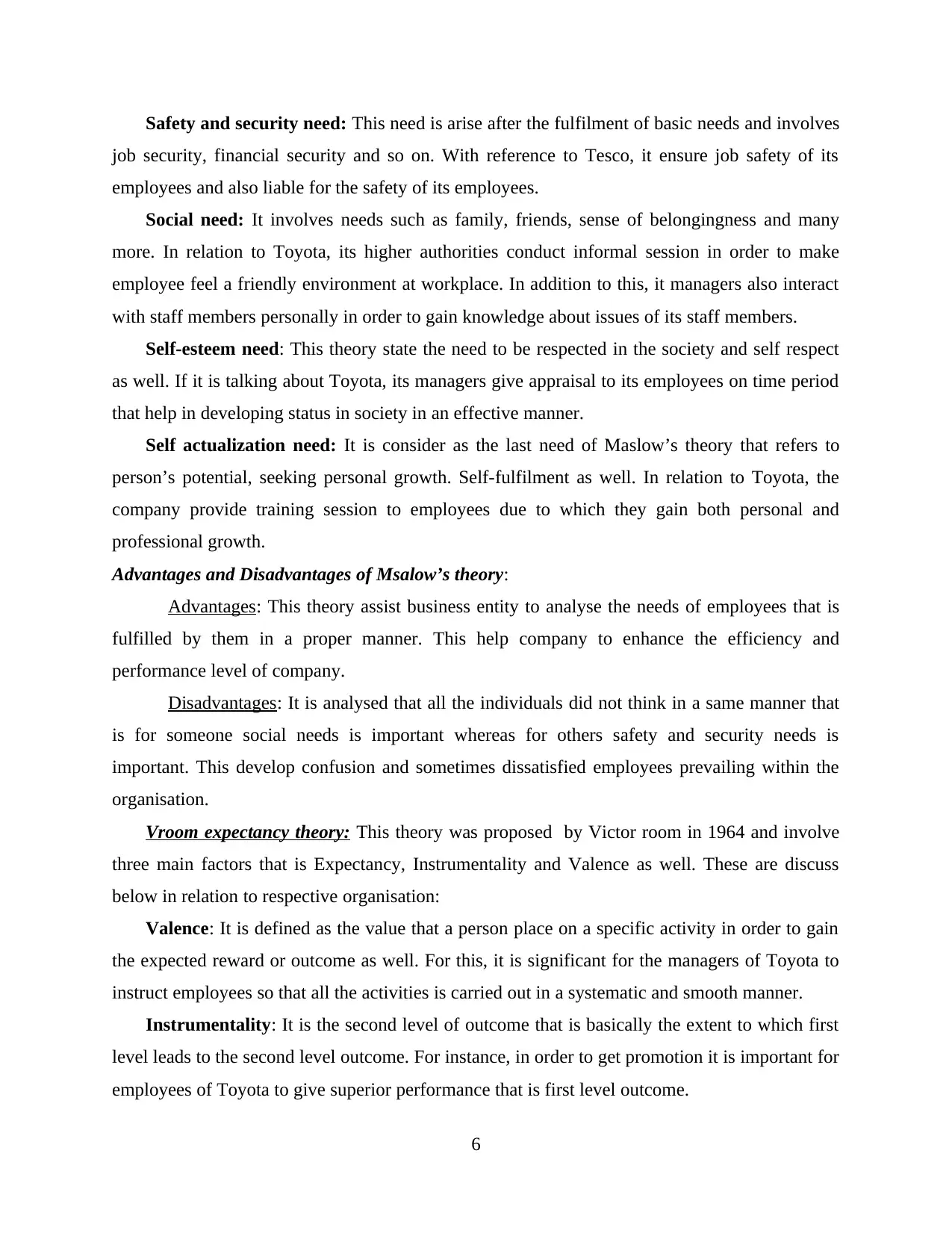
Safety and security need: This need is arise after the fulfilment of basic needs and involves
job security, financial security and so on. With reference to Tesco, it ensure job safety of its
employees and also liable for the safety of its employees.
Social need: It involves needs such as family, friends, sense of belongingness and many
more. In relation to Toyota, its higher authorities conduct informal session in order to make
employee feel a friendly environment at workplace. In addition to this, it managers also interact
with staff members personally in order to gain knowledge about issues of its staff members.
Self-esteem need: This theory state the need to be respected in the society and self respect
as well. If it is talking about Toyota, its managers give appraisal to its employees on time period
that help in developing status in society in an effective manner.
Self actualization need: It is consider as the last need of Maslow’s theory that refers to
person’s potential, seeking personal growth. Self-fulfilment as well. In relation to Toyota, the
company provide training session to employees due to which they gain both personal and
professional growth.
Advantages and Disadvantages of Msalow’s theory:
Advantages: This theory assist business entity to analyse the needs of employees that is
fulfilled by them in a proper manner. This help company to enhance the efficiency and
performance level of company.
Disadvantages: It is analysed that all the individuals did not think in a same manner that
is for someone social needs is important whereas for others safety and security needs is
important. This develop confusion and sometimes dissatisfied employees prevailing within the
organisation.
Vroom expectancy theory: This theory was proposed by Victor room in 1964 and involve
three main factors that is Expectancy, Instrumentality and Valence as well. These are discuss
below in relation to respective organisation:
Valence: It is defined as the value that a person place on a specific activity in order to gain
the expected reward or outcome as well. For this, it is significant for the managers of Toyota to
instruct employees so that all the activities is carried out in a systematic and smooth manner.
Instrumentality: It is the second level of outcome that is basically the extent to which first
level leads to the second level outcome. For instance, in order to get promotion it is important for
employees of Toyota to give superior performance that is first level outcome.
6
job security, financial security and so on. With reference to Tesco, it ensure job safety of its
employees and also liable for the safety of its employees.
Social need: It involves needs such as family, friends, sense of belongingness and many
more. In relation to Toyota, its higher authorities conduct informal session in order to make
employee feel a friendly environment at workplace. In addition to this, it managers also interact
with staff members personally in order to gain knowledge about issues of its staff members.
Self-esteem need: This theory state the need to be respected in the society and self respect
as well. If it is talking about Toyota, its managers give appraisal to its employees on time period
that help in developing status in society in an effective manner.
Self actualization need: It is consider as the last need of Maslow’s theory that refers to
person’s potential, seeking personal growth. Self-fulfilment as well. In relation to Toyota, the
company provide training session to employees due to which they gain both personal and
professional growth.
Advantages and Disadvantages of Msalow’s theory:
Advantages: This theory assist business entity to analyse the needs of employees that is
fulfilled by them in a proper manner. This help company to enhance the efficiency and
performance level of company.
Disadvantages: It is analysed that all the individuals did not think in a same manner that
is for someone social needs is important whereas for others safety and security needs is
important. This develop confusion and sometimes dissatisfied employees prevailing within the
organisation.
Vroom expectancy theory: This theory was proposed by Victor room in 1964 and involve
three main factors that is Expectancy, Instrumentality and Valence as well. These are discuss
below in relation to respective organisation:
Valence: It is defined as the value that a person place on a specific activity in order to gain
the expected reward or outcome as well. For this, it is significant for the managers of Toyota to
instruct employees so that all the activities is carried out in a systematic and smooth manner.
Instrumentality: It is the second level of outcome that is basically the extent to which first
level leads to the second level outcome. For instance, in order to get promotion it is important for
employees of Toyota to give superior performance that is first level outcome.
6
⊘ This is a preview!⊘
Do you want full access?
Subscribe today to unlock all pages.

Trusted by 1+ million students worldwide
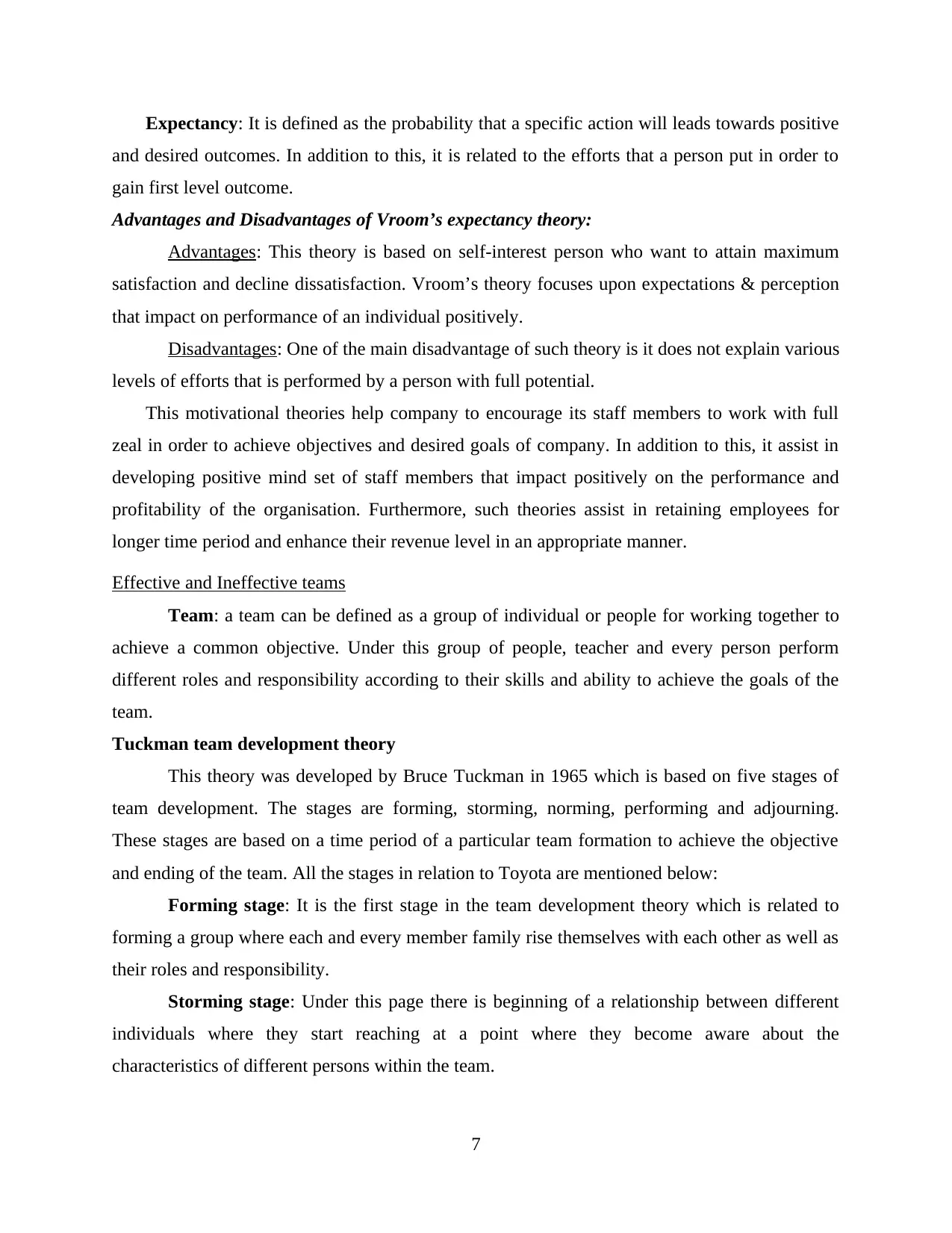
Expectancy: It is defined as the probability that a specific action will leads towards positive
and desired outcomes. In addition to this, it is related to the efforts that a person put in order to
gain first level outcome.
Advantages and Disadvantages of Vroom’s expectancy theory:
Advantages: This theory is based on self-interest person who want to attain maximum
satisfaction and decline dissatisfaction. Vroom’s theory focuses upon expectations & perception
that impact on performance of an individual positively.
Disadvantages: One of the main disadvantage of such theory is it does not explain various
levels of efforts that is performed by a person with full potential.
This motivational theories help company to encourage its staff members to work with full
zeal in order to achieve objectives and desired goals of company. In addition to this, it assist in
developing positive mind set of staff members that impact positively on the performance and
profitability of the organisation. Furthermore, such theories assist in retaining employees for
longer time period and enhance their revenue level in an appropriate manner.
Effective and Ineffective teams
Team: a team can be defined as a group of individual or people for working together to
achieve a common objective. Under this group of people, teacher and every person perform
different roles and responsibility according to their skills and ability to achieve the goals of the
team.
Tuckman team development theory
This theory was developed by Bruce Tuckman in 1965 which is based on five stages of
team development. The stages are forming, storming, norming, performing and adjourning.
These stages are based on a time period of a particular team formation to achieve the objective
and ending of the team. All the stages in relation to Toyota are mentioned below:
Forming stage: It is the first stage in the team development theory which is related to
forming a group where each and every member family rise themselves with each other as well as
their roles and responsibility.
Storming stage: Under this page there is beginning of a relationship between different
individuals where they start reaching at a point where they become aware about the
characteristics of different persons within the team.
7
and desired outcomes. In addition to this, it is related to the efforts that a person put in order to
gain first level outcome.
Advantages and Disadvantages of Vroom’s expectancy theory:
Advantages: This theory is based on self-interest person who want to attain maximum
satisfaction and decline dissatisfaction. Vroom’s theory focuses upon expectations & perception
that impact on performance of an individual positively.
Disadvantages: One of the main disadvantage of such theory is it does not explain various
levels of efforts that is performed by a person with full potential.
This motivational theories help company to encourage its staff members to work with full
zeal in order to achieve objectives and desired goals of company. In addition to this, it assist in
developing positive mind set of staff members that impact positively on the performance and
profitability of the organisation. Furthermore, such theories assist in retaining employees for
longer time period and enhance their revenue level in an appropriate manner.
Effective and Ineffective teams
Team: a team can be defined as a group of individual or people for working together to
achieve a common objective. Under this group of people, teacher and every person perform
different roles and responsibility according to their skills and ability to achieve the goals of the
team.
Tuckman team development theory
This theory was developed by Bruce Tuckman in 1965 which is based on five stages of
team development. The stages are forming, storming, norming, performing and adjourning.
These stages are based on a time period of a particular team formation to achieve the objective
and ending of the team. All the stages in relation to Toyota are mentioned below:
Forming stage: It is the first stage in the team development theory which is related to
forming a group where each and every member family rise themselves with each other as well as
their roles and responsibility.
Storming stage: Under this page there is beginning of a relationship between different
individuals where they start reaching at a point where they become aware about the
characteristics of different persons within the team.
7
Paraphrase This Document
Need a fresh take? Get an instant paraphrase of this document with our AI Paraphraser
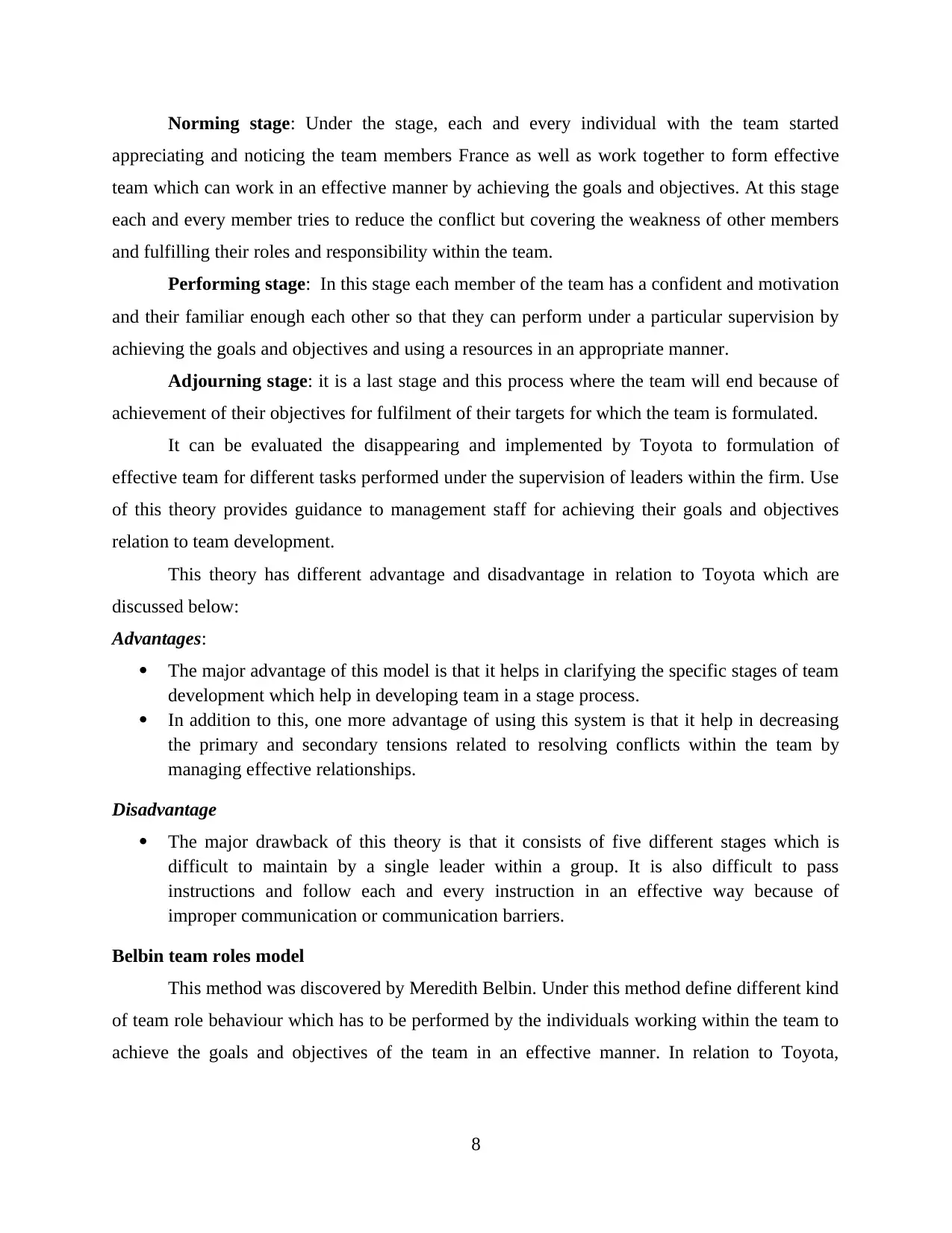
Norming stage: Under the stage, each and every individual with the team started
appreciating and noticing the team members France as well as work together to form effective
team which can work in an effective manner by achieving the goals and objectives. At this stage
each and every member tries to reduce the conflict but covering the weakness of other members
and fulfilling their roles and responsibility within the team.
Performing stage: In this stage each member of the team has a confident and motivation
and their familiar enough each other so that they can perform under a particular supervision by
achieving the goals and objectives and using a resources in an appropriate manner.
Adjourning stage: it is a last stage and this process where the team will end because of
achievement of their objectives for fulfilment of their targets for which the team is formulated.
It can be evaluated the disappearing and implemented by Toyota to formulation of
effective team for different tasks performed under the supervision of leaders within the firm. Use
of this theory provides guidance to management staff for achieving their goals and objectives
relation to team development.
This theory has different advantage and disadvantage in relation to Toyota which are
discussed below:
Advantages:
The major advantage of this model is that it helps in clarifying the specific stages of team
development which help in developing team in a stage process.
In addition to this, one more advantage of using this system is that it help in decreasing
the primary and secondary tensions related to resolving conflicts within the team by
managing effective relationships.
Disadvantage
The major drawback of this theory is that it consists of five different stages which is
difficult to maintain by a single leader within a group. It is also difficult to pass
instructions and follow each and every instruction in an effective way because of
improper communication or communication barriers.
Belbin team roles model
This method was discovered by Meredith Belbin. Under this method define different kind
of team role behaviour which has to be performed by the individuals working within the team to
achieve the goals and objectives of the team in an effective manner. In relation to Toyota,
8
appreciating and noticing the team members France as well as work together to form effective
team which can work in an effective manner by achieving the goals and objectives. At this stage
each and every member tries to reduce the conflict but covering the weakness of other members
and fulfilling their roles and responsibility within the team.
Performing stage: In this stage each member of the team has a confident and motivation
and their familiar enough each other so that they can perform under a particular supervision by
achieving the goals and objectives and using a resources in an appropriate manner.
Adjourning stage: it is a last stage and this process where the team will end because of
achievement of their objectives for fulfilment of their targets for which the team is formulated.
It can be evaluated the disappearing and implemented by Toyota to formulation of
effective team for different tasks performed under the supervision of leaders within the firm. Use
of this theory provides guidance to management staff for achieving their goals and objectives
relation to team development.
This theory has different advantage and disadvantage in relation to Toyota which are
discussed below:
Advantages:
The major advantage of this model is that it helps in clarifying the specific stages of team
development which help in developing team in a stage process.
In addition to this, one more advantage of using this system is that it help in decreasing
the primary and secondary tensions related to resolving conflicts within the team by
managing effective relationships.
Disadvantage
The major drawback of this theory is that it consists of five different stages which is
difficult to maintain by a single leader within a group. It is also difficult to pass
instructions and follow each and every instruction in an effective way because of
improper communication or communication barriers.
Belbin team roles model
This method was discovered by Meredith Belbin. Under this method define different kind
of team role behaviour which has to be performed by the individuals working within the team to
achieve the goals and objectives of the team in an effective manner. In relation to Toyota,
8
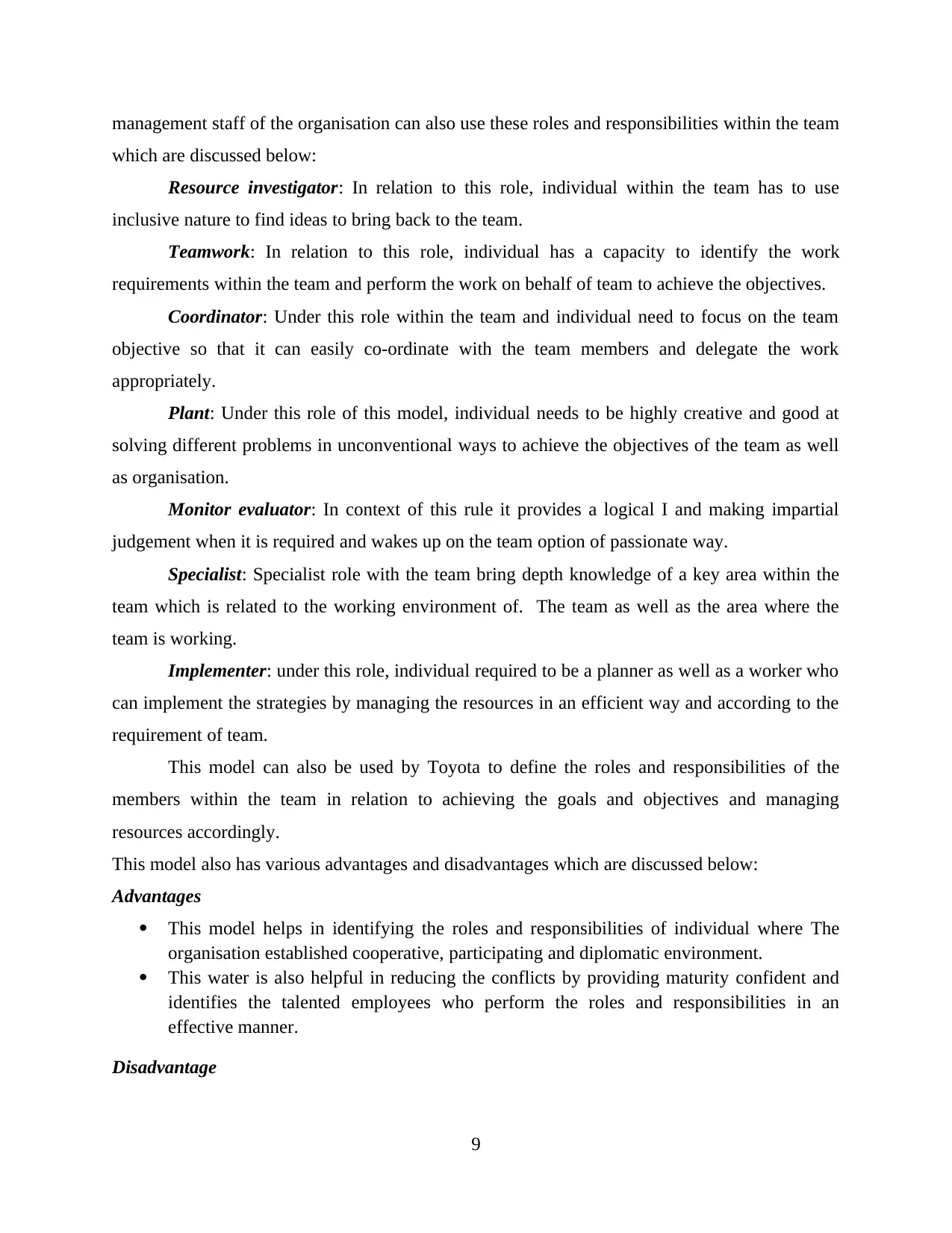
management staff of the organisation can also use these roles and responsibilities within the team
which are discussed below:
Resource investigator: In relation to this role, individual within the team has to use
inclusive nature to find ideas to bring back to the team.
Teamwork: In relation to this role, individual has a capacity to identify the work
requirements within the team and perform the work on behalf of team to achieve the objectives.
Coordinator: Under this role within the team and individual need to focus on the team
objective so that it can easily co-ordinate with the team members and delegate the work
appropriately.
Plant: Under this role of this model, individual needs to be highly creative and good at
solving different problems in unconventional ways to achieve the objectives of the team as well
as organisation.
Monitor evaluator: In context of this rule it provides a logical I and making impartial
judgement when it is required and wakes up on the team option of passionate way.
Specialist: Specialist role with the team bring depth knowledge of a key area within the
team which is related to the working environment of. The team as well as the area where the
team is working.
Implementer: under this role, individual required to be a planner as well as a worker who
can implement the strategies by managing the resources in an efficient way and according to the
requirement of team.
This model can also be used by Toyota to define the roles and responsibilities of the
members within the team in relation to achieving the goals and objectives and managing
resources accordingly.
This model also has various advantages and disadvantages which are discussed below:
Advantages
This model helps in identifying the roles and responsibilities of individual where The
organisation established cooperative, participating and diplomatic environment.
This water is also helpful in reducing the conflicts by providing maturity confident and
identifies the talented employees who perform the roles and responsibilities in an
effective manner.
Disadvantage
9
which are discussed below:
Resource investigator: In relation to this role, individual within the team has to use
inclusive nature to find ideas to bring back to the team.
Teamwork: In relation to this role, individual has a capacity to identify the work
requirements within the team and perform the work on behalf of team to achieve the objectives.
Coordinator: Under this role within the team and individual need to focus on the team
objective so that it can easily co-ordinate with the team members and delegate the work
appropriately.
Plant: Under this role of this model, individual needs to be highly creative and good at
solving different problems in unconventional ways to achieve the objectives of the team as well
as organisation.
Monitor evaluator: In context of this rule it provides a logical I and making impartial
judgement when it is required and wakes up on the team option of passionate way.
Specialist: Specialist role with the team bring depth knowledge of a key area within the
team which is related to the working environment of. The team as well as the area where the
team is working.
Implementer: under this role, individual required to be a planner as well as a worker who
can implement the strategies by managing the resources in an efficient way and according to the
requirement of team.
This model can also be used by Toyota to define the roles and responsibilities of the
members within the team in relation to achieving the goals and objectives and managing
resources accordingly.
This model also has various advantages and disadvantages which are discussed below:
Advantages
This model helps in identifying the roles and responsibilities of individual where The
organisation established cooperative, participating and diplomatic environment.
This water is also helpful in reducing the conflicts by providing maturity confident and
identifies the talented employees who perform the roles and responsibilities in an
effective manner.
Disadvantage
9
⊘ This is a preview!⊘
Do you want full access?
Subscribe today to unlock all pages.

Trusted by 1+ million students worldwide
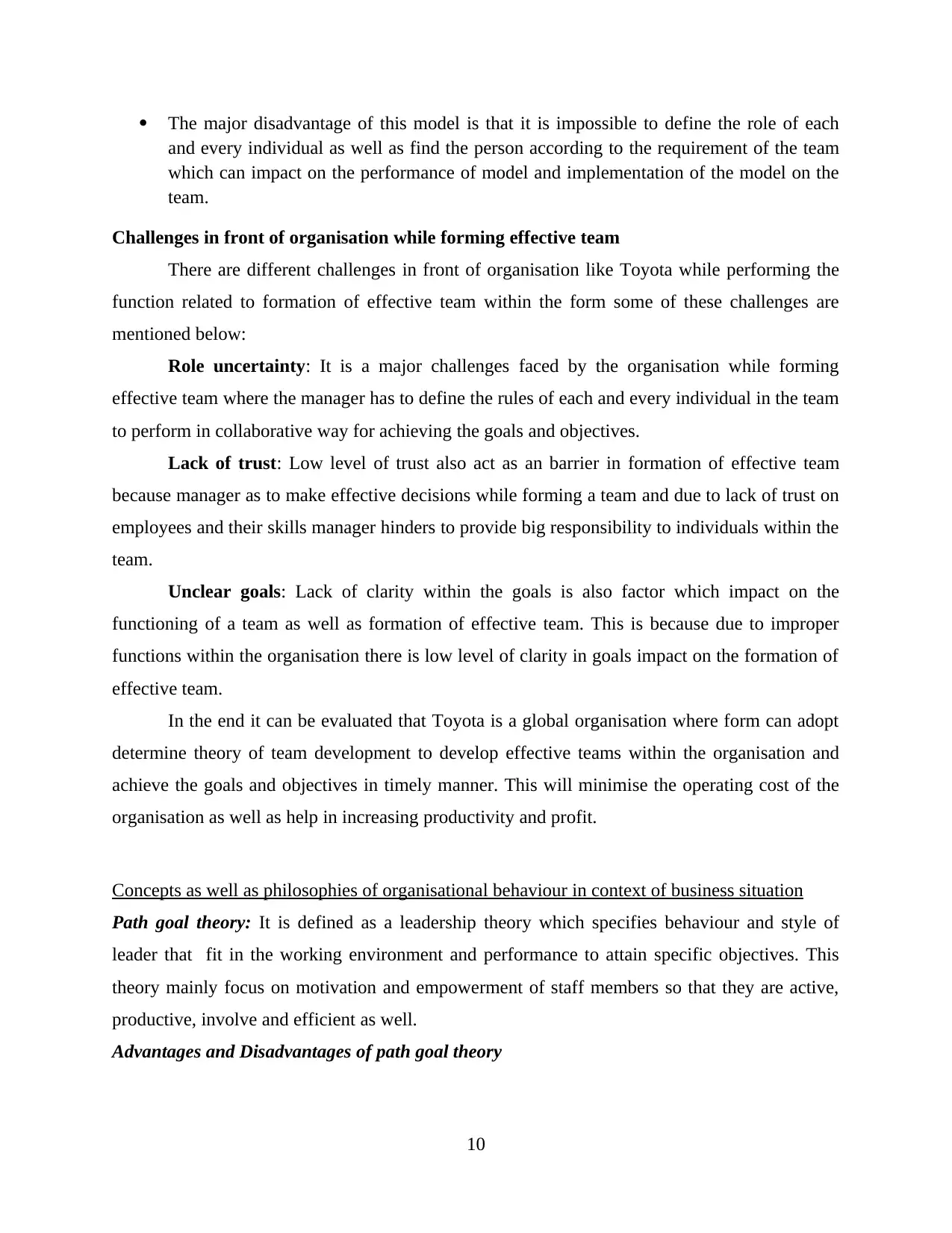
The major disadvantage of this model is that it is impossible to define the role of each
and every individual as well as find the person according to the requirement of the team
which can impact on the performance of model and implementation of the model on the
team.
Challenges in front of organisation while forming effective team
There are different challenges in front of organisation like Toyota while performing the
function related to formation of effective team within the form some of these challenges are
mentioned below:
Role uncertainty: It is a major challenges faced by the organisation while forming
effective team where the manager has to define the rules of each and every individual in the team
to perform in collaborative way for achieving the goals and objectives.
Lack of trust: Low level of trust also act as an barrier in formation of effective team
because manager as to make effective decisions while forming a team and due to lack of trust on
employees and their skills manager hinders to provide big responsibility to individuals within the
team.
Unclear goals: Lack of clarity within the goals is also factor which impact on the
functioning of a team as well as formation of effective team. This is because due to improper
functions within the organisation there is low level of clarity in goals impact on the formation of
effective team.
In the end it can be evaluated that Toyota is a global organisation where form can adopt
determine theory of team development to develop effective teams within the organisation and
achieve the goals and objectives in timely manner. This will minimise the operating cost of the
organisation as well as help in increasing productivity and profit.
Concepts as well as philosophies of organisational behaviour in context of business situation
Path goal theory: It is defined as a leadership theory which specifies behaviour and style of
leader that fit in the working environment and performance to attain specific objectives. This
theory mainly focus on motivation and empowerment of staff members so that they are active,
productive, involve and efficient as well.
Advantages and Disadvantages of path goal theory
10
and every individual as well as find the person according to the requirement of the team
which can impact on the performance of model and implementation of the model on the
team.
Challenges in front of organisation while forming effective team
There are different challenges in front of organisation like Toyota while performing the
function related to formation of effective team within the form some of these challenges are
mentioned below:
Role uncertainty: It is a major challenges faced by the organisation while forming
effective team where the manager has to define the rules of each and every individual in the team
to perform in collaborative way for achieving the goals and objectives.
Lack of trust: Low level of trust also act as an barrier in formation of effective team
because manager as to make effective decisions while forming a team and due to lack of trust on
employees and their skills manager hinders to provide big responsibility to individuals within the
team.
Unclear goals: Lack of clarity within the goals is also factor which impact on the
functioning of a team as well as formation of effective team. This is because due to improper
functions within the organisation there is low level of clarity in goals impact on the formation of
effective team.
In the end it can be evaluated that Toyota is a global organisation where form can adopt
determine theory of team development to develop effective teams within the organisation and
achieve the goals and objectives in timely manner. This will minimise the operating cost of the
organisation as well as help in increasing productivity and profit.
Concepts as well as philosophies of organisational behaviour in context of business situation
Path goal theory: It is defined as a leadership theory which specifies behaviour and style of
leader that fit in the working environment and performance to attain specific objectives. This
theory mainly focus on motivation and empowerment of staff members so that they are active,
productive, involve and efficient as well.
Advantages and Disadvantages of path goal theory
10
Paraphrase This Document
Need a fresh take? Get an instant paraphrase of this document with our AI Paraphraser
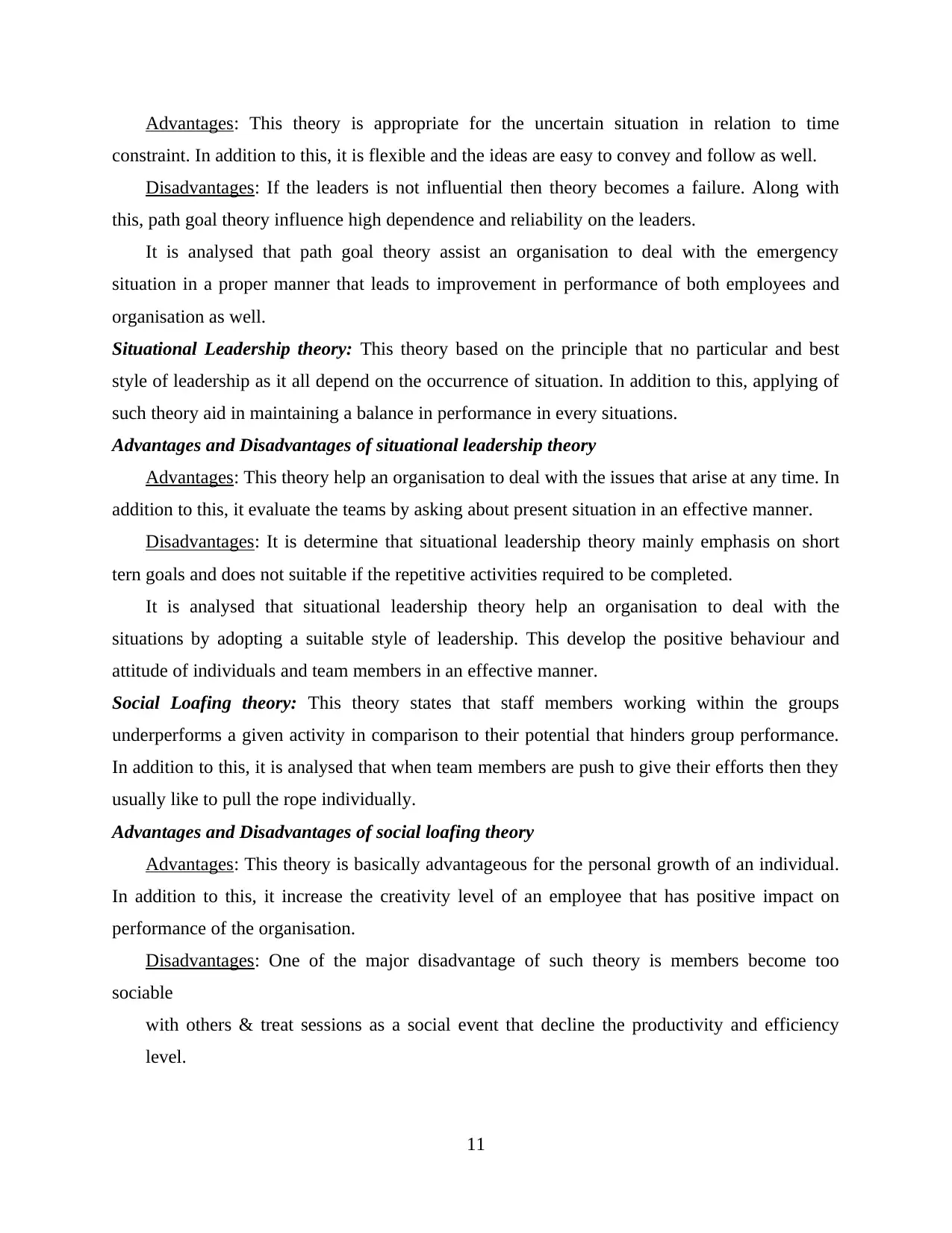
Advantages: This theory is appropriate for the uncertain situation in relation to time
constraint. In addition to this, it is flexible and the ideas are easy to convey and follow as well.
Disadvantages: If the leaders is not influential then theory becomes a failure. Along with
this, path goal theory influence high dependence and reliability on the leaders.
It is analysed that path goal theory assist an organisation to deal with the emergency
situation in a proper manner that leads to improvement in performance of both employees and
organisation as well.
Situational Leadership theory: This theory based on the principle that no particular and best
style of leadership as it all depend on the occurrence of situation. In addition to this, applying of
such theory aid in maintaining a balance in performance in every situations.
Advantages and Disadvantages of situational leadership theory
Advantages: This theory help an organisation to deal with the issues that arise at any time. In
addition to this, it evaluate the teams by asking about present situation in an effective manner.
Disadvantages: It is determine that situational leadership theory mainly emphasis on short
tern goals and does not suitable if the repetitive activities required to be completed.
It is analysed that situational leadership theory help an organisation to deal with the
situations by adopting a suitable style of leadership. This develop the positive behaviour and
attitude of individuals and team members in an effective manner.
Social Loafing theory: This theory states that staff members working within the groups
underperforms a given activity in comparison to their potential that hinders group performance.
In addition to this, it is analysed that when team members are push to give their efforts then they
usually like to pull the rope individually.
Advantages and Disadvantages of social loafing theory
Advantages: This theory is basically advantageous for the personal growth of an individual.
In addition to this, it increase the creativity level of an employee that has positive impact on
performance of the organisation.
Disadvantages: One of the major disadvantage of such theory is members become too
sociable
with others & treat sessions as a social event that decline the productivity and efficiency
level.
11
constraint. In addition to this, it is flexible and the ideas are easy to convey and follow as well.
Disadvantages: If the leaders is not influential then theory becomes a failure. Along with
this, path goal theory influence high dependence and reliability on the leaders.
It is analysed that path goal theory assist an organisation to deal with the emergency
situation in a proper manner that leads to improvement in performance of both employees and
organisation as well.
Situational Leadership theory: This theory based on the principle that no particular and best
style of leadership as it all depend on the occurrence of situation. In addition to this, applying of
such theory aid in maintaining a balance in performance in every situations.
Advantages and Disadvantages of situational leadership theory
Advantages: This theory help an organisation to deal with the issues that arise at any time. In
addition to this, it evaluate the teams by asking about present situation in an effective manner.
Disadvantages: It is determine that situational leadership theory mainly emphasis on short
tern goals and does not suitable if the repetitive activities required to be completed.
It is analysed that situational leadership theory help an organisation to deal with the
situations by adopting a suitable style of leadership. This develop the positive behaviour and
attitude of individuals and team members in an effective manner.
Social Loafing theory: This theory states that staff members working within the groups
underperforms a given activity in comparison to their potential that hinders group performance.
In addition to this, it is analysed that when team members are push to give their efforts then they
usually like to pull the rope individually.
Advantages and Disadvantages of social loafing theory
Advantages: This theory is basically advantageous for the personal growth of an individual.
In addition to this, it increase the creativity level of an employee that has positive impact on
performance of the organisation.
Disadvantages: One of the major disadvantage of such theory is members become too
sociable
with others & treat sessions as a social event that decline the productivity and efficiency
level.
11
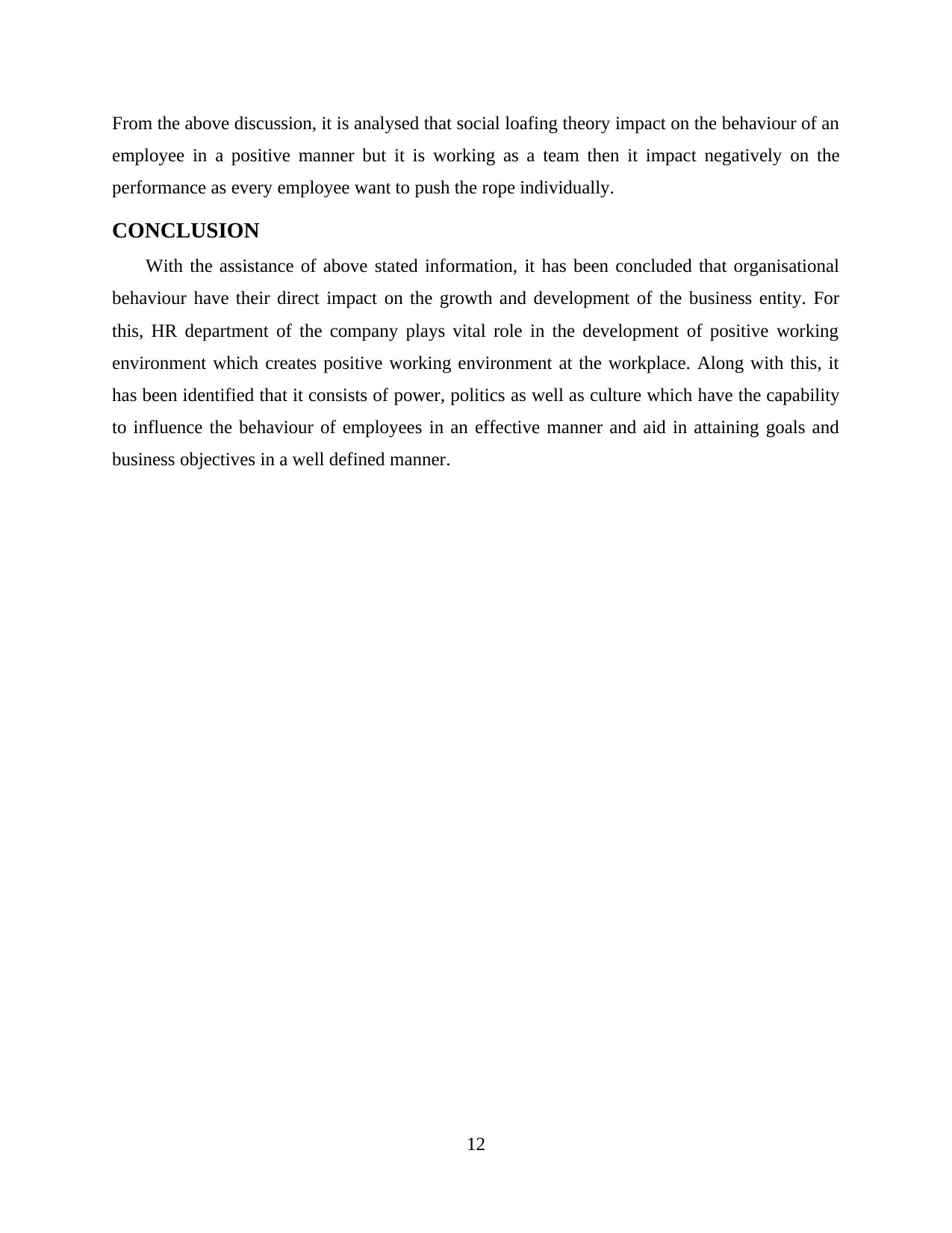
From the above discussion, it is analysed that social loafing theory impact on the behaviour of an
employee in a positive manner but it is working as a team then it impact negatively on the
performance as every employee want to push the rope individually.
CONCLUSION
With the assistance of above stated information, it has been concluded that organisational
behaviour have their direct impact on the growth and development of the business entity. For
this, HR department of the company plays vital role in the development of positive working
environment which creates positive working environment at the workplace. Along with this, it
has been identified that it consists of power, politics as well as culture which have the capability
to influence the behaviour of employees in an effective manner and aid in attaining goals and
business objectives in a well defined manner.
12
employee in a positive manner but it is working as a team then it impact negatively on the
performance as every employee want to push the rope individually.
CONCLUSION
With the assistance of above stated information, it has been concluded that organisational
behaviour have their direct impact on the growth and development of the business entity. For
this, HR department of the company plays vital role in the development of positive working
environment which creates positive working environment at the workplace. Along with this, it
has been identified that it consists of power, politics as well as culture which have the capability
to influence the behaviour of employees in an effective manner and aid in attaining goals and
business objectives in a well defined manner.
12
⊘ This is a preview!⊘
Do you want full access?
Subscribe today to unlock all pages.

Trusted by 1+ million students worldwide
1 out of 14
Related Documents
Your All-in-One AI-Powered Toolkit for Academic Success.
+13062052269
info@desklib.com
Available 24*7 on WhatsApp / Email
![[object Object]](/_next/static/media/star-bottom.7253800d.svg)
Unlock your academic potential
Copyright © 2020–2025 A2Z Services. All Rights Reserved. Developed and managed by ZUCOL.





